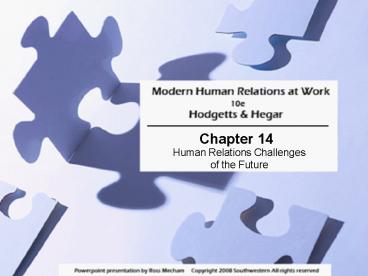Human Relations Challenges of the Future - PowerPoint PPT Presentation
1 / 14
Title:
Human Relations Challenges of the Future
Description:
... are open and responsive to feelings and emotions and the world around them. ... Video Cameras and Privacy. Cost-cutting Labor Practices. Impact of Global Events ... – PowerPoint PPT presentation
Number of Views:276
Avg rating:3.0/5.0
Title: Human Relations Challenges of the Future
1
Chapter 14
- Human Relations Challenges of the Future
2
Learning Objectives
- Describe the characteristics of creative people.
- Explain how creativity in an organization setting
can be both encouraged and nurtured. - Discuss some of the reasons why the nature of
work is changing and the role that imagination,
entrepreneurial spirit, engaged employees, and
hiring practice are playing in this process.
3
Learning Objectives (contd.)
- Review the current state of diversity in the
workplace. - Explain how awareness-based, skill-based, and
integrated-based training programs are being used
to deal with the challenge of diversity. - Identify the major pillars of world-class
organizations and explain how organizations are
using the pillars. - Describe several human relation challenges facing
managers in the next decade. - Explore the possibilities of switching careers.
4
Characteristics of Creative People
- Creative people tend to be bright rather than
brilliant. - Creative people have a youthful curiosity
throughout their lives. - Creative people are open and responsive to
feelings and emotions and the world around them. - Creative people tend to have a positive
self-image.
5
Characteristics of Creative People (contd.)
- Creative people have the ability to tolerate
isolation. - Creative people frequently are nonconformists.
- Creative people enjoy finding imaginative
solutions to problems. - Creative people are persistent.
6
Figure 14.1 - Job Requirements Distribution
Superimposed on Ability Distribution
7
Contrasts in Moral Reasoning
- Men are more likely to
- Respect the other persons rights
- Value the importance of being decisive
- Seek a solution that is objectively fair
- Rely on rules
- Be guided by logic
- Accept authority
- Women are likely to
- Respect the other persons feelings
- Avoid being judgmental
- Search for a compromise
- Rely on communication
- Be guided by emotion
- Challenge authority
8
Meeting the Cultural Diversity Challenge
- Women and Minorities
- Pay for Women
- Upper Management Positions
- Harassment, Discrimination and Retaliation
- Other Forms of Discrimination
- Diversity Training
9
The Major Pillars of World-Class Organizations
World-Class Organizations
Fluid, Flexible or Virtual Organizations
Technological Support
Customer-based Focus
Continuous Improvement
Creative HRM
Egalitarian Climate
10
Creating World-Class Organizations
- Train workers to employ multiple skills
- Rely heavily on cross-training and job rotation
of employees - Create multifunctional work teams
- Empower employees
- Use innovative approaches that reduce the time
needed to deliver goods and services
11
Creative Human Resource Management
- Constant training
- Employee suggestion systems
- Empowered teams
- Promotion of those who take risks, whether they
succeed or fail - Creation of an effective reward system that
encourages teamwork and effort
12
Some of the Human Relations Challenges in the
Future
- Organized labor
- Going Euro
- The simmering malaise
- Defined benefit plans
- Consumer-driven health care
- Recruiting older workers
- Skill shortage
13
Changes Impact Human Relations Management
- Identity Management
- Building Designs
- Video Cameras and Privacy
- Cost-cutting Labor Practices
- Impact of Global Events
- Opportunities for Older Employees
- Impact of Technology
- Collaboration Between Employees
14
Key Terms in the Chapter
- Reengineering
- Entrepreneurial spirit
- Engaged employees
- Awareness-based diversity training
- Skill-based diversity training
- World-class organization
- Virtual organization
- Asset-based thinking































